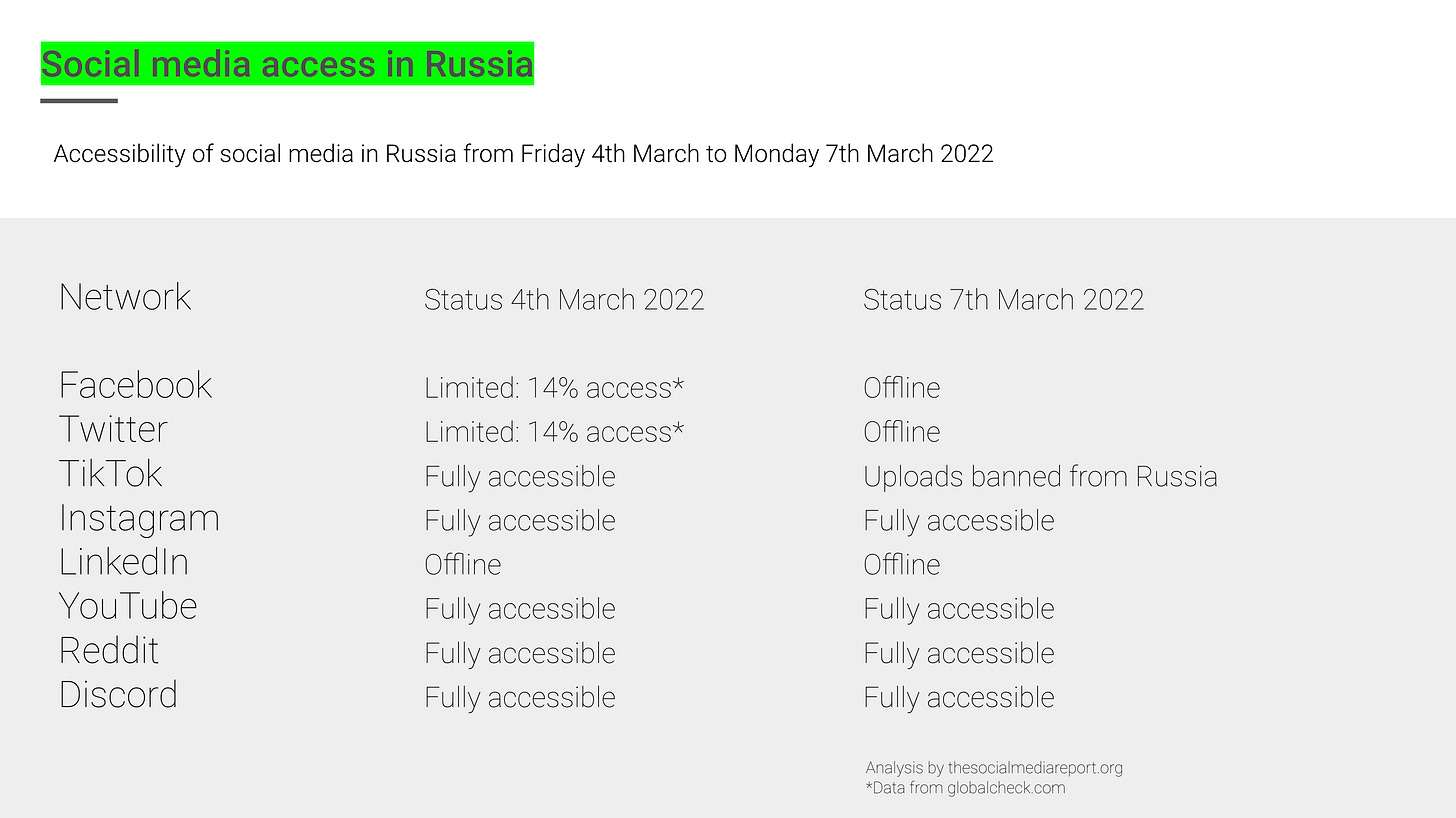The Social Media Report #31: social media in Russia and Ukraine
How social media is being used as the invasion of Ukraine develops
The use of social media as a weapon on the front line by both Russia and Ukraine is like nothing seen before in a conflict of this kind. While Ukraine has mobilised ‘IT Armies’ through tweets from its digital minister, Russia has moved to control what information can be seen in the country by its own people.
Now, as the situation Ukraine intensifies, the social media front is shifting and changing on a daily basis. With entire social networks and independent media publishers are being taken offline in Russia, and others limiting access of their own accord, I’ve taken a look at some of the ways this online war is being waged.
A look Ukrainian social media minister Mykhailo Fedorov
First, an example of social media put to use by political leadership, authentically from the top, and used to galvanise activists and western democracies alike. Ukraine’s youngest cabinet minister is Mykhailo Fedorov, and he is Ukraine’s Vice Prime Minister and Minister of Digital Transformation. His Twitter following is 227,000 and he has been using his online profile as a key weapon against Russia, pressuring western tech brands to sanction the Russian government, sharing footage from the ground, and encouraging his followers to join his IT Army on Telegram, which already numbers 35,000 members.
The Wall Street Journal reports that Fedorov was leading a roughly 250-person ministry when Russia invaded, a department whose goal was to connect more Ukrainians to the Internet and modernise digital services. The BBC reports that Fedorov is now operating from a bunker in a secret location in Kyiv, and he’s now leading a team of somewhere between 250 government specialists to many thousands of virtual volunteers.
Russia reinvents the media landscape
Russia has long been a country with a skewed social media landscape. Previous to its invasion of Ukraine, access to Twitter and LinkedIn was limited in Russia, LinkedIn more so than Twitter, meaning if you were in Russia, you’d have found it pretty difficult to use either of the social networks.
Then last week, Russia announced the banning of Facebook, and reports from people in Russia stated that Twitter was taken offline too. The site Globalcheck currently shows Facebook, Twitter and LinkedIn as completely offline in Russia. One TikTok citizen reporter says this is so that Russia can ensure it controls what people are told, and where they can communicate with one another.
In terms of mainstream media, The BBC has also been blocked in Russia, resulting in the broadcaster publishing instructions on how to view its news coverage on the dark web, through Tor. This is alongside a number of independent media outlets being taken offline last week.
TikTok is perhaps the most interesting of developments, however. When Russia passed a new law on Friday which threatens imprisonment for sharing what Russia considers to be false information, TikTok’s response was to itself impose a ban on people in Russia uploading content to the app, including live streaming, which was proving to be a key way for younger Russians to discover what was happening in Ukraine. People with authentic stories to tell on TikTok are finding a huge audience internationally however, just taking TikTok user RussianPappiiiis as an example, having gained 70,000 followers and 6 million views just over the weekend for her explainer videos.
The next frontier for social media
Russia’s stance on social media access will continue to develop, no doubt. To combat this, Instagram has already launched encrypted DMs in Russia and Ukraine, Telegram’s use is surging, with some related news channels, used as social media groups, growing by over 80,000 members daily, and even metaverse worlds are filling with Russians and Ukrainians seeking access to open media.
Emerging networks in live streaming, from video on YouTube and Twitch, to audio on Discord, and text in Telegram, will be the networks to surge through the Ukraine invasion. Russian YouTuber Yury Dud is an example of a creator that is finding influence amongst the fog - his Telegram channel already boasts 867,000 followers, rapidly approaching the total he has of 900k over on Twitter, alongside his 9.2m YouTube subscribers.
As the situation develops in Ukraine, the changes in social media access in Russia, and the tactics deployed by Ukraine will both be critical observations, and blueprints for national and international defence strategies of the future.
The Social Media Report is written by Drew Benvie, founder & CEO of Battenhall.
You can follow The Social Media Report on Twitter at @TheSMReport. Suggestions for stories can be emailed to db@battenhall.com. Thank you for reading.





